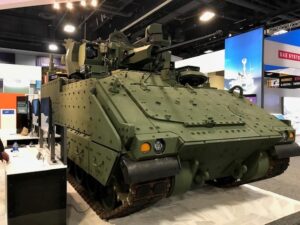BAE Systems is offering a purpose-built design for the Army’s Optionally Manned Fighting Vehicle competition, with a lead official detailing the offering’s emphasis on modular open architecture and the use of a new “rolling lab” technology demonstrator to test new capabilities.
Jim Miller, BAE Systems’ senior director of business development for combat mission systems, told reporters ahead of this week’s Association of the United States Army conference that the Army’s approach to the Bradley-replacement program focused on transformational characteristics required a new vehicle design rather than building off an existing platform.

“With the way that OMFV is currently structured and the approach that’s been laid out by the Army, we believe that this is a new vehicle design project. This is not really achievable by modifying an existing vehicle,” Miller said. “We have a great team of engineers and we asked them to think outside of the box, don’t be bound by the old way we’ve done things in the past and really stretch out to something transformational. And [we’ve asked them] to do that in a way that’s not just single-channel transformational but broadly transformational. And, as I’ve said, that’s a new design vehicle.”
BAE Systems was one of five competitors the Army selected in July to work on refining their OMFV concepts over the next 15 months (Defense Daily, July 23).
While Miller said he could not disclose additional specifics on the offering, BAE Systems previously announced it has partnered with Elbit Systems of America on its offering, which is providing the turret solution (Defense Daily, April 15).
“There’s a bunch of other announcements we’re probably going to make soon about other folks that have teamed up with us to do that,” Miller said.
Miller said BAE Systems is focused on meeting the Army’s emphasis on taking a modular open architecture approach to OMFV to build in capacity for rapid integration of new technologies and enable the potential move to vehicle electrification capabilities.
“The Army likes to talk about reducing the cognitive load on the soldier. We’re going to take it one better. We’re going to augment the soldier’s capability to do things on the battlefield,” Miller said. “That architecture is really going to be the key transformational piece of OMFV, we think. That’s going to allow you to grow. It’s going to allow you to insert new technology. It’s going to allow you to insert new propulsion. You know, over time, the Army may go to fully electric or hydrogen [power]. We’re going to be able to transition that into this vehicle given the openness of the architecture that we’re setting out to develop for this vehicle.”
BAE Systems has also brought its new RB301 technology demonstrator platform to AUSA, which Miller described as a “rolling lab” that shows the plug-in-play capability approach afford by the modular open architecture emphasis and will highlight advanced technologies that could play a part in a potential OMFV platform.
“It serves as kind of our infantry fighting vehicle rolling lab. It’s a vehicle that runs. It allows us to task, integrate and mature the ideas that come out of our digital engineering operation and really get feedback from soldiers and military operators about the vehicle that will help us develop a better OMFV,” Miller said. “We’re also looking for industry partners that are going to walk up [to RB301] and go ‘I can do better than what you’ve got on there’ or ‘I’ve got a new idea.’ We’re looking for the best and brightest. It helps attract a discussion from soldiers and from other members of industry who could be of great assistance in helping us get this right.”
The RB301 at AUSA features an Elbit medium-caliber 30mm turret, a high-voltage electric vehicle architecture and a range of advanced situational awareness sensors and systems, according to Miller.